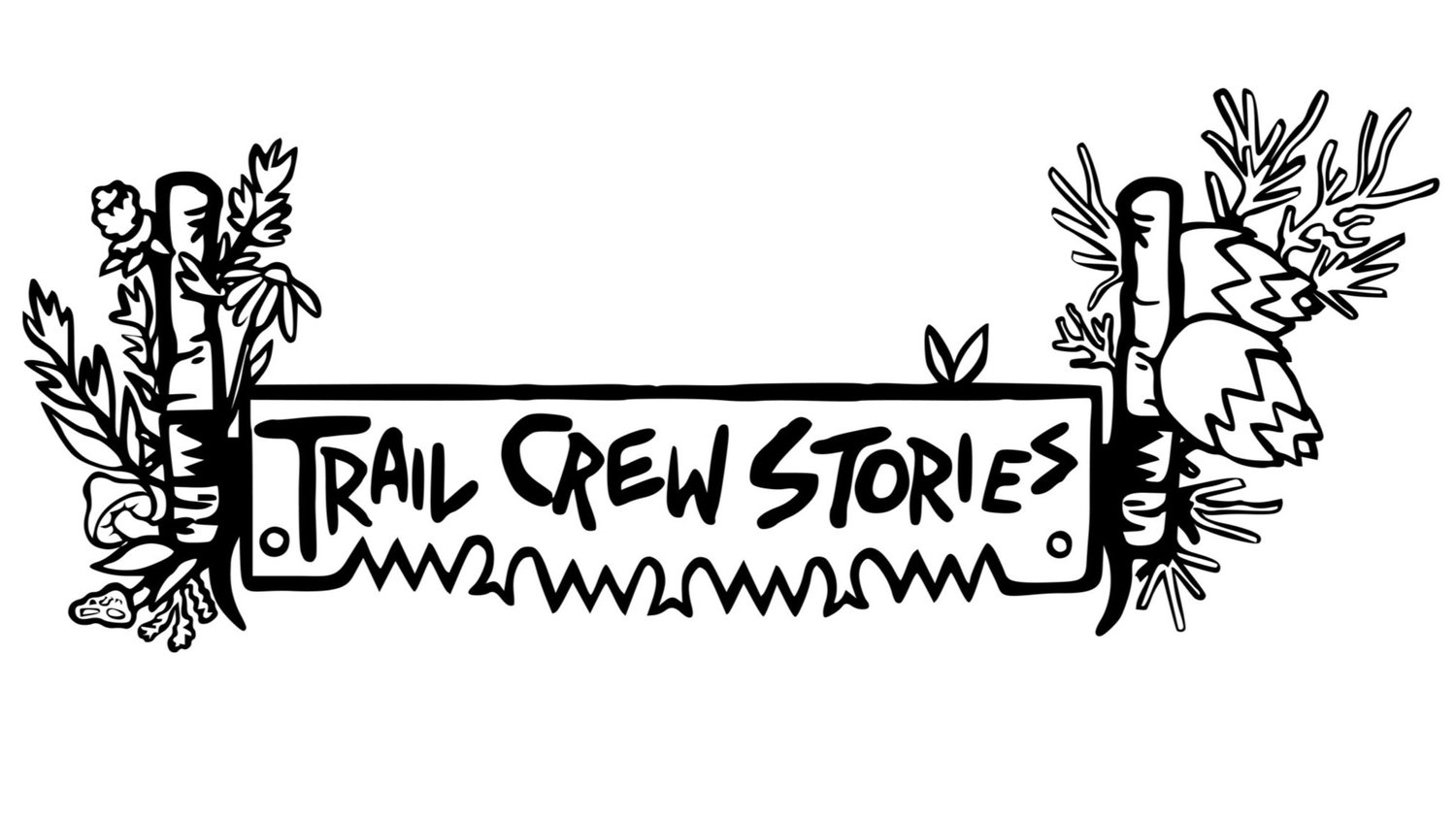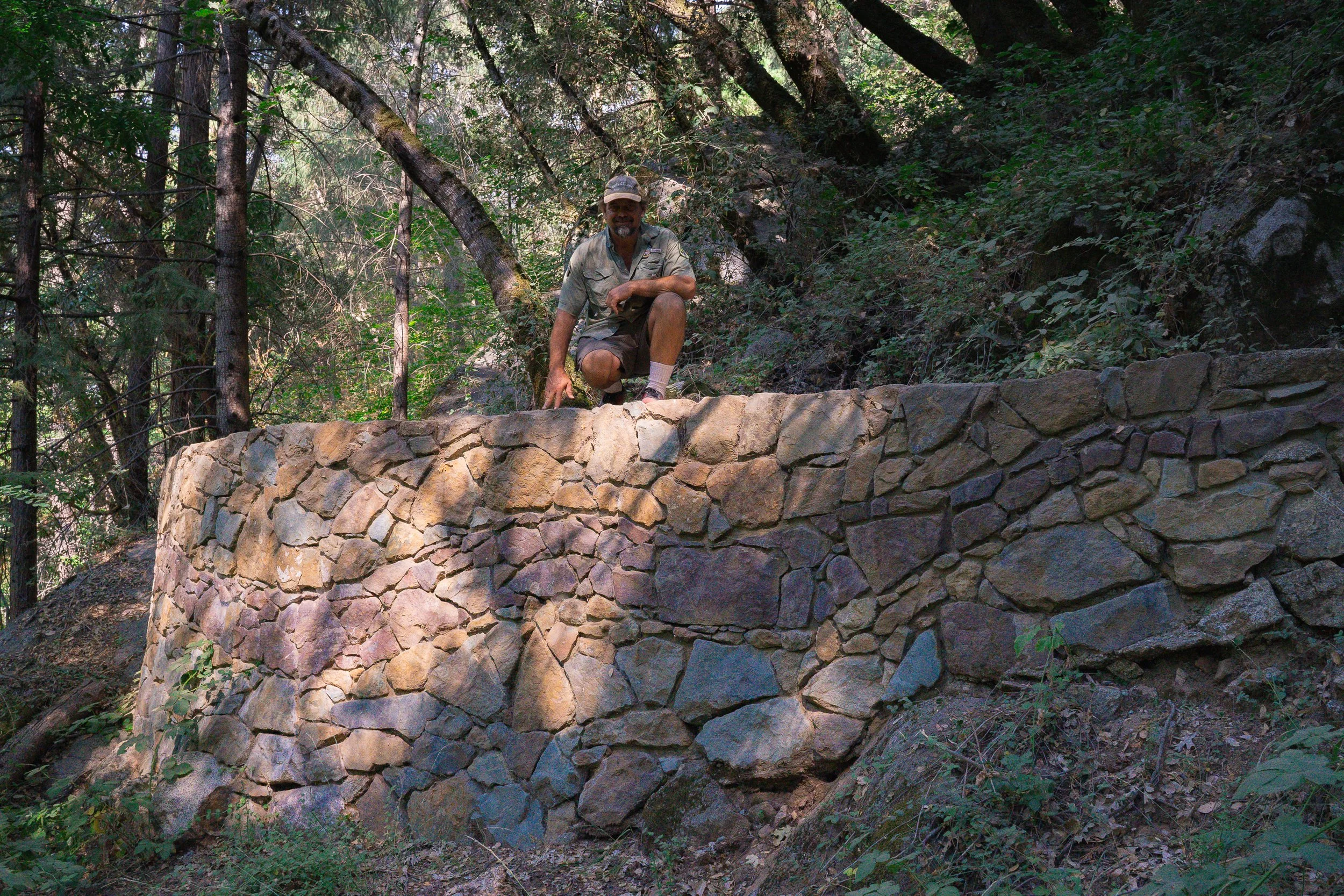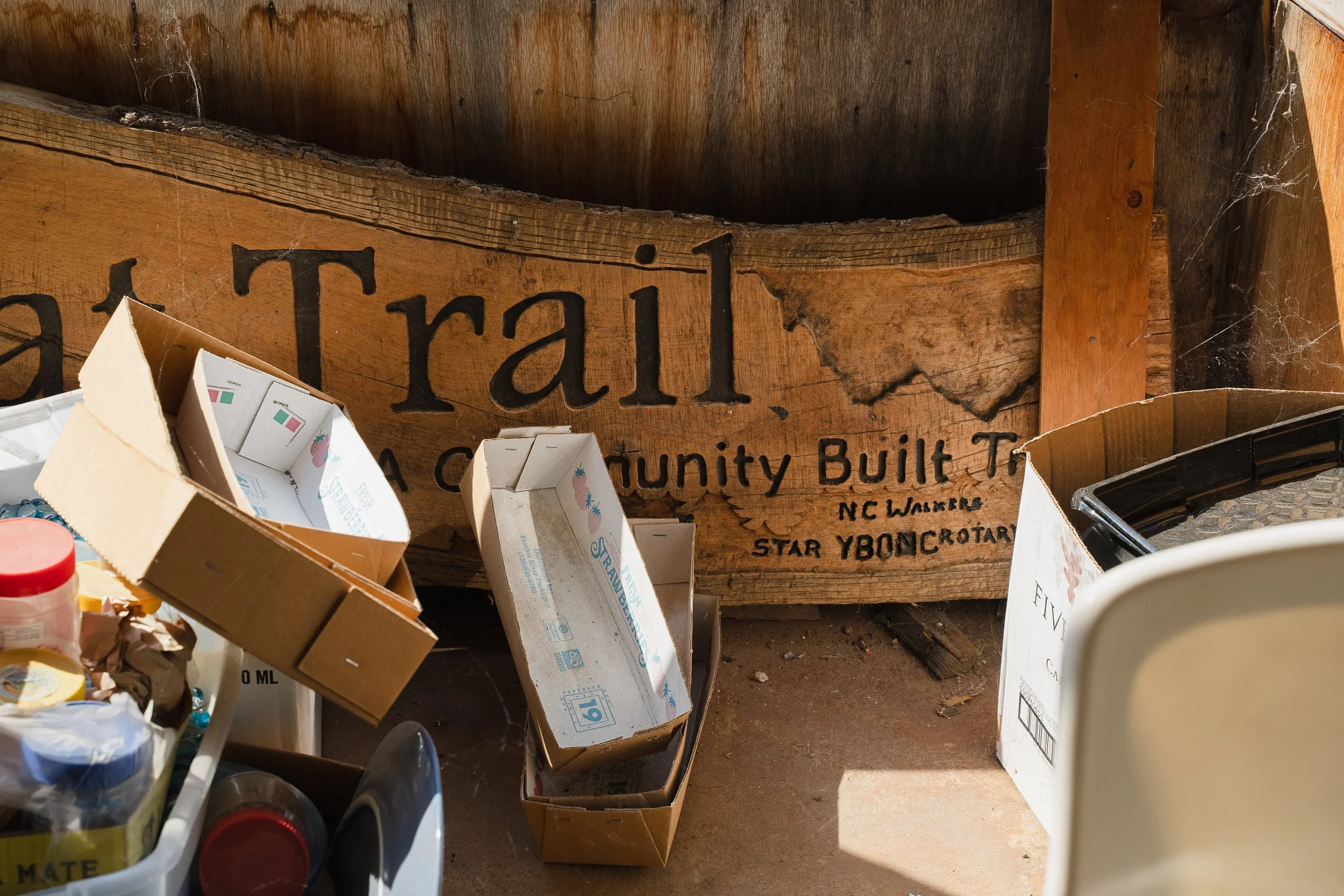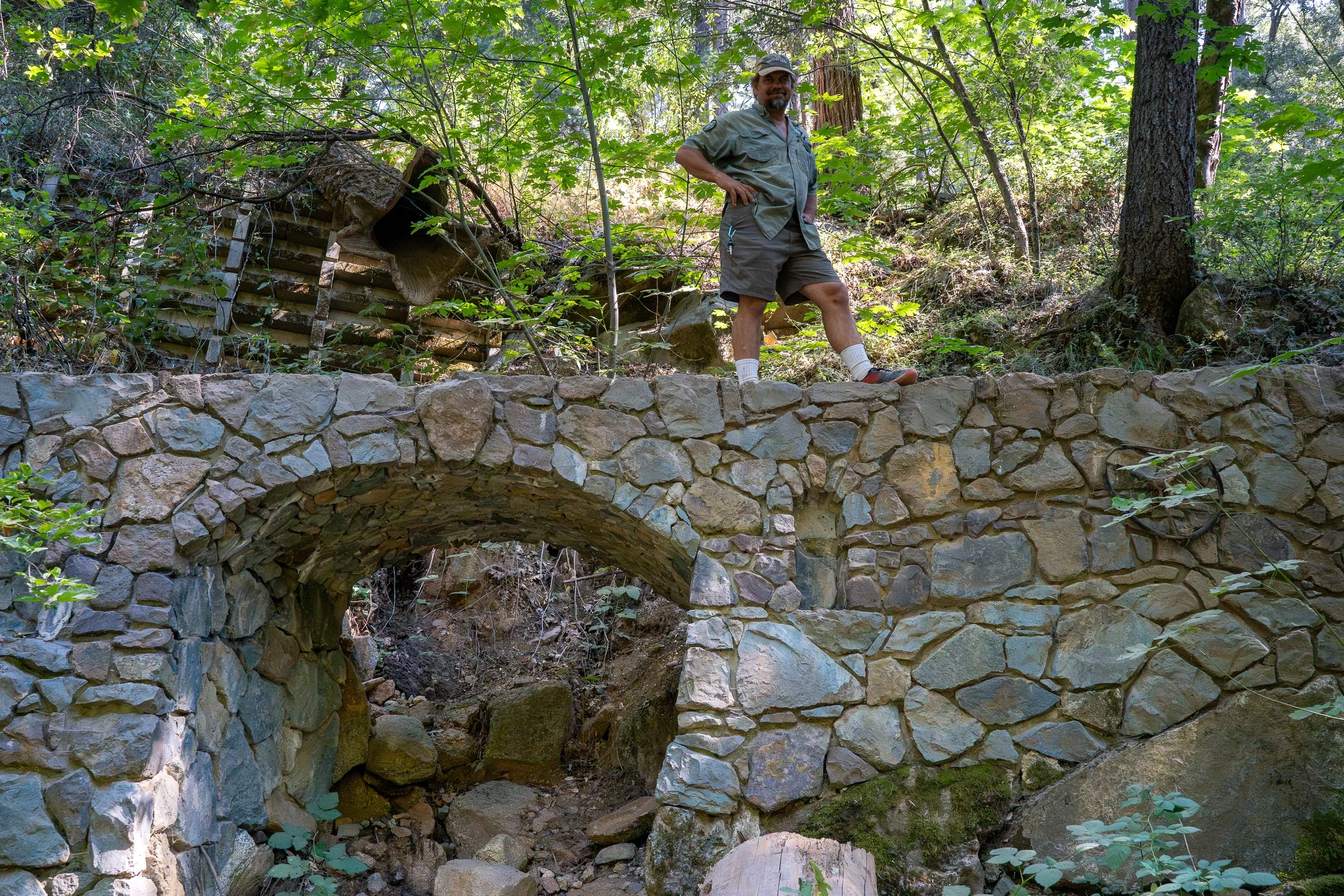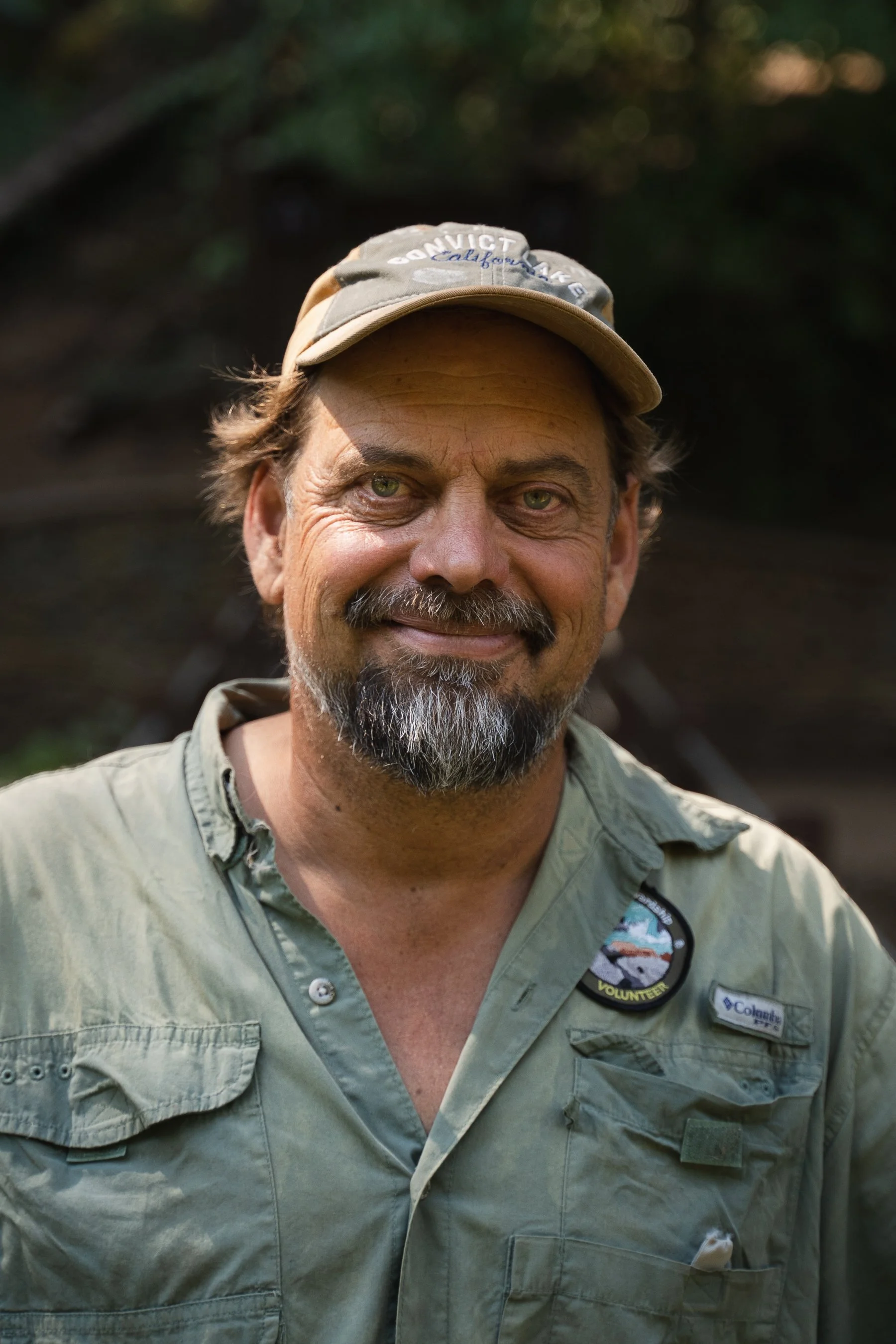Zachi Anderson: “Make trails more than a dotted line.”
“You should talk to this guy Zachi Anderson, he’s up in Nevada City. He’s got some pretty wild ideas. And he builds Hobbit houses. Seems really interesting.”
Following this advice from a friend in trails, I reached out to Zachi via social media. A message led to a phone call which, many months later, led to shaking Zachi’s hand on a stifling July day in Nevada City, California.
Zachi Anderson is the Executive Director of The Forest Trails Alliance (FTA), a volunteer-run non-profit dedicated to developing trail systems in greater Nevada County, California. Frustrated by the lack of interconnectivity of disparate trails and siloed land management in the area, Zachi and the team at FTA have a progressive vision of a grassroots approach to trail planning.
After some big project accomplishments in the early 2010s (namely the stunning Deer Creek Tribute Trail in Nevada City), opportunities fizzled as they became mired in bureaucratic red tape and funding issues. Mismanaged grant funds by a partner on a big project left FTA in a six-figure hole, out from which they are still trying to climb. In this way, FTA became a victim of the very problems it aims to fix: interagency deadlock, financial constraints, and lack of institutional oversight.
Things are quiet at FTA these days, but Zachi still has big ideas for the future of the organization. My visit with him began with a tour of the former gas station on the outskirts of town that now houses excavators, tools, and other equipment, and that he hopes will someday be a venue for community parties to celebrate trails.
“I want opening a new trail to feel like a baby shower, where the entire community welcomes this new thing into the world. I want to have hoedowns in here,” Zachi told me as he showed me around the 7,000 square foot garage.
Broadly, Zachi’s vision is, in his words, “to make trails more than a dotted line.” In our interview, he shares his ideas about trails, neighborhood participation, heritage building, craftsmanship, and art—the sum total of which he refers to as “Zachi-ology.” He draws inspiration from the trail systems in New Zealand, sustainable home-building, and the impressive grassroots organization of Burning Man (even though he’s never been). For Zachi, trails are not merely infrastructure, but also a catalyst for civic engagement.
While his ideas are indeed ambitious, they are grounded in decades of experience in the field. To some they may seem eccentric, but I left the conversation inspired to get back to work on the trail.
Highlining an excavator across the Yuba River for the Deer Creek Tribute Trail Project in 2014.
Image courtesy of Zachi Anderson
Zachi Anderson shows off some of the equipment in the FTA shop.
Joe Gibson: How did you wind up in Nevada City building trails?
Zachi Anderson: “I grew up in a really rural part of Vermont, so I spent most of my childhood out adventuring in the forest or sailing on Lake Champlain. Then, at the age of 14, I got my first work with the Youth Conservation Corps. I had my rite of passage, so to speak, in crafting trails and civic service. Right after that, I moved to California with my mom to finish school in Sacramento. Out of my love for recreation and mountain biking, I moved to Nevada City from Sacramento.
That's it. This is where I grew up, this is where I want to live. In 1986, I started the Fat Tire Samurai Mountain Bike Club, and then in 1988 I opened the bike store, Samurai Bikes, and ran that until ‘96. Then I sold it and got into Forest Trails Alliance, our 501c3 nonprofit, and that was really out of this vision of seeing how many people were motivated to increase the trail infrastructure that we wanted, but we just lacked organized capacity.
The nonprofit was developed to create greater networking around partners and volunteers, as well as shared resources—not just buying a six pack of beer for volunteers, but also investing in mini excavators, equipment, and education. Recognizing the high, high bar of expectations that land managers had around hydrology and environmental considerations and design components that went into crafting trails.
I did the federal trails training program that all state parks and National Park Service people go through. I was one of the few NGOs that went through that training. In part, I did that so that I would have better insight into the degree of bureaucracy and the process that they have to go through so that I could be of service to them and not just a burden—so I could actually be an integral part of the process in supporting projects being developed.
From that approach, I really grew this vision that this would be such an amazing tool and resource for every village and community to have so that they didn't have to spend $25,000 to $70,000 a mile for a dirt path.
Given how important pedestrian trails are for our vitality and connection with nature and well-being, we need to be able to figure out how to shortcut to those outcomes. Especially when so many people are willing to donate their time and energy and resources to be a part of that creation. It just seems like process was the missing component.
Image courtesy of Zachi Anderson
JG: Could you elaborate a little bit more on how art and aesthetics drives your trail design?
ZA: As a craftsperson and as an artist, I'm someone who's really been involved in alternative building and nature.
Heritage crafting and building has always been on my radar. But one of the things I realized, from going to trail conferences and whatnot, is that they're usually saturated by either environmental firms or companies that are selling these manufactured products.
My experience of working with a lot of agencies that often have limited staffing resources is that many of the staff are wearing many hats. They’re incorporating plastic Trex and other manufactured products into trail infrastructure, which I see as a kind of transgression.
What we want to do is really utilize techniques that are sustainable, that are using non-toxic elements. Using things that can sustain natural fire ecology.
Compare the difference between using a locally-milled cedar product versus a fir that was non-sustainably harvested in Canada and then impregnated with copper sulfates and then shipped from Canada to use in the forest in California. That’s a real big miss when it comes to the opportunity of just building with what's local, right?
I think that people just like working with their hands, and so bringing heritage crafting in and more creativity and character is important. We live a life that's so manufactured, where whatever we may buy, 50,000 other people have bought. We live in these gingerbread houses that may be mirrored by another 500 houses in the same neighborhood, right? So I think there's a high degree of value and art and uniqueness and character and grit and experience ,and those things all come into play when you're bringing unique attributes into a natural experience.
Wet stone retaining wall under construction on the Deer Creek Tribute Trail in 2014.
Image courtesy of Zachi Anderson
The same wall in 2024.
JG: It seems like there's almost two different trail building industries: on one hand, there’s building mountain bike flow trails with an excavator; on the other, there’s more traditional backcountry trail building. Where do you see opportunities for those two separate worlds to collaborate?
I think overall what we don't have is the investment in our volunteers and community builders that it really allows those two worlds to collaborate.
I think that mountain biking brings a lot of passion and interest and resources into a build, but often it's for a short term gain and they're not really investing in the long game in regards to technique, capacity, resources, relationships.
Often, this work is done in exclusion to the greater community needs as far as pedestrian infrastructure. So you get this unique type of trail or infrastructure that serves a small paradigm of users. It doesn’t really address the overall dysfunctionality of how hard it is to just get pedestrian infrastructure that's connective.
I think agency work is often so limited by fear and bureaucracy that it tends to be very detail-rich, but without a lot of creativity. Same with commercial work– the goal is just to get it done with as little effort as possible to get paid. With commercial work, in particular, the whole relationship to place and need is absent.
With agency work, the agency has few resources and little experience with design. So the alignment might be created substandard, and then all this work goes into getting that corridor approved for the environmental work and then all this work goes into getting funding and it's after the money is acquired—only then—that the professional trail builder, who often has the greatest amount of wisdom and experience, gets invited to the table. But at that point, the project is so locked in by the environmental corridor and the design that there's little room for adaptability. It's a dysfunctional system. I think the biggest shortcoming of public agencies is their isolation from one another. So they have a tendency to build these little satellite parking areas with these out and back little trail experiences without a more global perspective around functional connectivity.
Those are all usually driven by agencies who are working within their own jurisdiction for these satellite builds. What’s lacking is the more global approach to how trails can be a multi-day or cross jurisdictional connective part of our community, which brings in the functionality of it.
A bridge built by FTA using ferrocement faux bois technique.
Image courtesy of Zachi Anderson
JG: Can you elaborate more on this vision of yours? What would this look like?
ZA: I think our world is upside down in many ways. I think that we're most effective in ourselves, grounded within our own sense of being. Then like little ripples going out, our connection with our partners and our family, and then our neighborhoods, and then our villages. As we leave the shores of our village and start getting into larger regional conceptions, we lose that tactile effectiveness.
If I were to envision how to affect transformation in a way where we could have more meaningful pedestrian infrastructure, it would start by empowering neighborhoods. Because neighbors are the first embodiment of collectives that have a vested interest in caring. Just like any user group, they're going to steward or maintain the trails that they ride or that they hike.
Neighborhoods are one of the most effective ways that our county has been addressing fire, as an example. They have a FireWise program that empowers neighborhoods by zip code or whatever.
Moving from a neighborhood up to the next level: Nevada County has 300 miles of incorporated road. Two-thirds of all that public egress is undeveloped. Meaning that it's just raw land that's set aside that no one uses for any reason, that's there specifically for us to use to get from place to place. The only portion of that that's developed is for cars. Walking or riding along these crazy fast roadways with vehicles and distracted drivers is just not workable. So I think right off the bat, beyond neighborhoods, creating simple dirt paths within those public rights of way that aren't adjacent to the actual improved roadway is transformational.
But the final way is just that every community generally does not have any kind of expertise or capability to develop basic pedestrian infrastructure. Just a simple class one trail, which is six feet wide with two inch thick asphalt on 8 feet and 2 inches of compacted crushed gravel, the average cost for that is $300,000 per mile.
But the actual cost of materials to build it is $15,000. So there's this huge uphill challenge to afford thoughtful pedestrian infrastructure because we are not investing on a base level within our own capacity versus relying on a bloated contracting system, which usually is reserved for these massive highway corporations who charge these exorbitant prices.
On a civic level, we need to rethink from a ground level up. How can we be effective in planning and orchestrating with as little higher-up manipulation as possible? Starting with our own hearts and minds, we can then work up to our neighborhoods and then villages. And if every village had that capacity to manifest their own infrastructure, that solves our problem.
It's trusting that every village has children that they care about, that every village has people that want to be active and healthy, that want to be mobile, that want to be outside of their cars. That trust that people are aware of COVID-19, global climate change, and the massive amount of pollution, and that we need to change how we live our lives.
The systems that we're relying on– our city councils, our county– they're not taking a proactive approach. They are not introducing programs for positive change. They are not seizing upon innovations like electric bikes and creating innovative programs to encourage people to use them.
We need to do that in the same way we approach art and theater, and that's through civic institutions. Because civic institutions will drive government agencies. Agencies are systems. They are not responsive, adaptive, human elements. They are machines to carry out a very predetermined, fact-based, repetitive type of work.
And that's needed. We need those. But we also need institutions where humans and people with emotions and needs and hearts can step up and be vital and influential in creating what's going to be next.
I've been working for 30 years now with public servants. They're incredibly devout, humble servants that really do their best in service of the community. They are just not empowered to be creative, they're not empowered to be adaptive. We need to be able to recognize the limits of those agencies and have them doing what they're really good at. The public servants that I've worked with, they love to show up as a gift to the community. They want to be change agents. So if we can create the organizations that can empower and support them, it's a win-win. We just can't be sitting in our armchairs waiting for the world to change around us. We need to be kicking the ball in the field.
JG: And where do you see volunteers fitting into this?
ZA: Everywhere. Money has gotten us greed. Money has gotten us famine. Money has gotten us global pollution and warming. Money is a handy tool, but it's not a healthy obsession. The things that bring us the most meaning is helping, is being a gift, is showing up and being valued, making a difference, really feeling like you belong.
Those are the things that I think make people happy and secure–not money. Money is an easy ticket to buy the next consumer item, which just consolidates more wealth and exaggerates the issues that we're already suffering.
The reality is that I think we need a system that's built around people's intrinsic love and care for the community that they live in. That’s what regionalism is about. You don't shit in your own living room, right? Corporations will destroy foreign environments because they don't live there and they don't care. And what they're seeking is profit. But if you live in a community and you have to face your peers, you go to the pub that night to have a beer, some guy punches you in the face because you fucked up his backyard. That's consequence, that helps to moderate behavior in a way that human civilization has been moderated for 500,000 years. But now we've removed ourselves from that level of consequence to where we can be unholy destructive. So for me, volunteerism can really bring us together.
That’s what we need. We need unifying aspects. Things that we have in common with each other. Not more ideas on how we're unique and against each other.
Zachi and FTA crew working on a dry stone retaining wall. The back of the excavator says “Bitchin Trail Comes Out This End.”
Image courtesy of Zachi Anderson
JG: What are some of those unifying aspects?
ZA: Creating that kind of chamber of commerce or that umbrella organization like Crested Butte, or Steamboat Springs, or Park City, or Mammoth, or Tahoe City, all have done. They have an overreaching civic institution that brings all the land managers, the business community, the different NGOs all under one tent.
Ninety percent of all pedestrian infrastructure including mountain bike trails is multi-use, it's a mandate that’s really hard to get around. And even though I'm a diehard mountain biker, I absolutely support getting multi-use trails figured out first. Because I know that if we have capacity to build out pedestrian infrastructure as a whole, that mountain biking trails are going to go through the roof. That'll just naturally happen. Mountain bike trails are the peak of the iceberg.
We're community members first. And that includes children and people with dogs and everybody.
Stone arch bridge under construction on the Deer Creek Tribute Trail in 2014. Note the metal culvert pipe above.
Image courtesy of Zachi Anderson
The culvert pipe could not be moved, so Zachi and his team disguised it as a fallen log using a technique called ferrocement faux bois.
Image courtesy of Zachi Anderson
The same bridge in 2024.
JG: Any thoughts or comments for the record?
I often am asked why I do what I do. Or, people say ‘You're not paid?’ as this incredible kind of illustrative, ‘huh?’ For me, at 60, and looking back over the last 30 years of really active engagement in this area, this has been the most rewarding part of my life. If I look at how money has impacted my life, I'd be thinking, ‘why was I wasting so much time earning money?’
My hope is that, similar to church, once you get the initial concepts through the door, that people will find joy there, that part of this discovery process is bigger than the infrastructure we're talking about.
Burning Man happens out of that focus on experience and crafting and creativity and collective development. I'm not sure about the nudity thing with trail building. And if all of the drugs are necessarily needed. But I think there are lots of examples of how those aspects are not only such healthy components to being human that are needed in our culture, but also a vital fuel and motivating role that can play in us as people accomplishing this needed goal.
It's about our connection to belonging, the sense of value that we get out of contributing. And making a difference. Those things bring me more joy than anything else. My relationships with other people and those values. I think that's one thing that's a very important fuel for this engine that we're trying to design.
It is the ultimate sustainable fuel that has nothing to do with this caustic capital fuel that we think we need to get anything done.
We will always have people saying, ‘Dude, just dig the dirt!’ I'm like, ‘No, dude, digging the dirt is just an inconsequential whimsical sideline to the joy that we experience in having a great time together.’”
Learn more about the Forest Trails Alliance and their work at their website.
What was that about “Hobbit House,” you ask? Learn more about Zachi’s contracting business, Casa di Terra, and his portfolio of whimsical builds at casaditerra.net.
